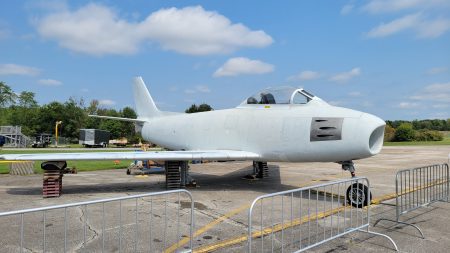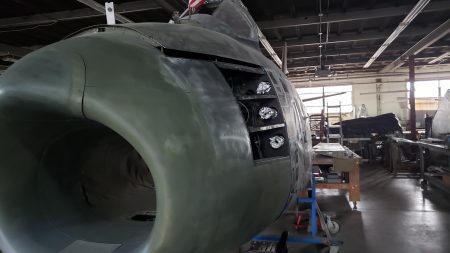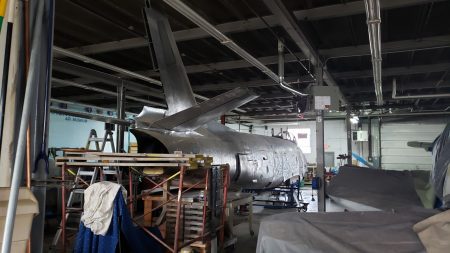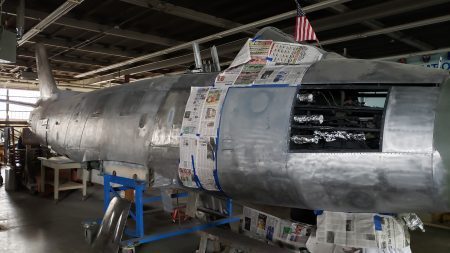Our Aircraft’s History
North American F-86A-5-NA (S/N 48-263; MSN #43610) ~ The Sabre, sometimes called the Sabrejet, was America’s first swept-wing fighter. She was needed during the Korean War to counter the similarly-winged Soviet MiG-15. The US Navy and US Marine versions were the FJ-2/-3 “Fury”.
This Sabre was built at the North American Aviation plant in Inglewood, California and delivered to the US Air Force on August 9, 1949. The F-86 had her first assignment with the 4th Fighter-Interceptor Wing, (Continental Air Command), Langley Air Force Base (AFB), Virginia. Here are her other travels, including the Korean War:
- 1950 – 2757th Air Base Group (Air Material Command), Cleveland, Ohio
- 1950 – 4th Fighter-Interceptor Wing (CAC) Langley AFB, Virginia
- 1950 – 336th Fighter-Interceptor Squadron (CAC), Dover AFB, Delaware
- 1950 – 4th Fighter-Interceptor Wing (Far East Air Force) Johnson Air Base, Japan; additional deployments to Taegu AB, Suwon AB and Kimpo AB, Korea
- 1952 – 6400th Air Depot Wing (FEAF), Kisarazu AB, Japan
- 1952 – Returned to North American Aviation, Fresno, California
- 1953 – Sacramento Air Material Area, McClelland AFB, California
- 1953 – 15th Fighter-Interceptor Squadron (ADC), Davis-Monthan AFB, Arizona
- 1954 – 194th Fighter-Bomber Squadron, Air National Guard (ANG), Haywood, California
- 1954- 196th Fighter-Bomber Squadron, ANG, Ontario, California
- 1957 – Transferred to the New England Air Museum, Windsor Locks, Connecticut
- 2004 – Transferred to the United States Air Force Museum, Dayton, Ohio
- 2014, April 2 – MAPS Air Museum received on indefinite loan from the US Air Force Museum the F-86A Sabre and is now under final renovation by the guidance of Crew Chief Chet Starn.
Specifications/Performance (F-86F-40-NA)
- Role: Fighter

- Manufacturer: North American
- First flight: October 1, 1947
- Introduction: May 12, 1949 (USAF)
- Retired: 1965 (US); 1994 (Bolivia)
- Produced: 1949-1956
- Built: 9,860
- Unit cost: $219,457 (F-86E)
- Crew: 1
- Length: 37 ft 1 in
- Wingspan: 37 ft
- Height: 14 ft 1 in
- Empty weight: 11,125 lb
- Max takeoff weight: 18,152 lb
- Engine: 1 x General Electric J47-GE-27 turbojet, 5,910 lbf
- Max speed: 68 mph at sea level
- Range: 1,525 mi
- Combat radius: 414 mi
- Service ceiling: 49,600 ft
Armament, notable
- Guns: 6 x .50 in M3 Browing machine gun (1,800 rounds total)
- Rockets: variety of launchers: example, 2 Matra pod with 18 SNEB 68 mm rockets per pod
- Bombs: Up to 5,300 lb of payload or napalm canisters or tactical nuclear bomb
Museum display notes: to be determined
Designed to replace: North American P-51 “Mustang” and the stop-gap North American FJ-1 “Fury”
Replaced by: North American FJ-4 “Fury” (US Navy) & the North American F-100 Super Sabre (US Air Force)
- After over 8 years in the restoration building, she is awaiting final assembly, painting/markings in late summer 2022.




